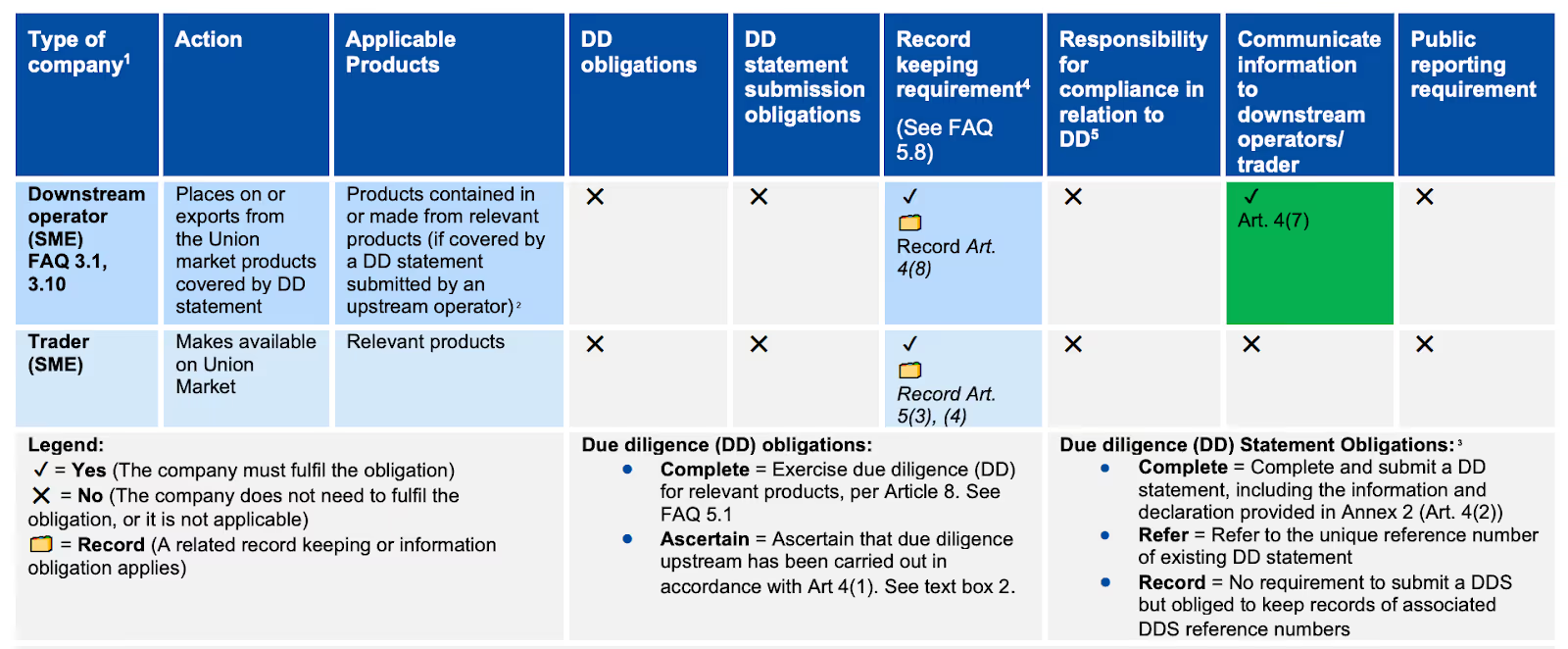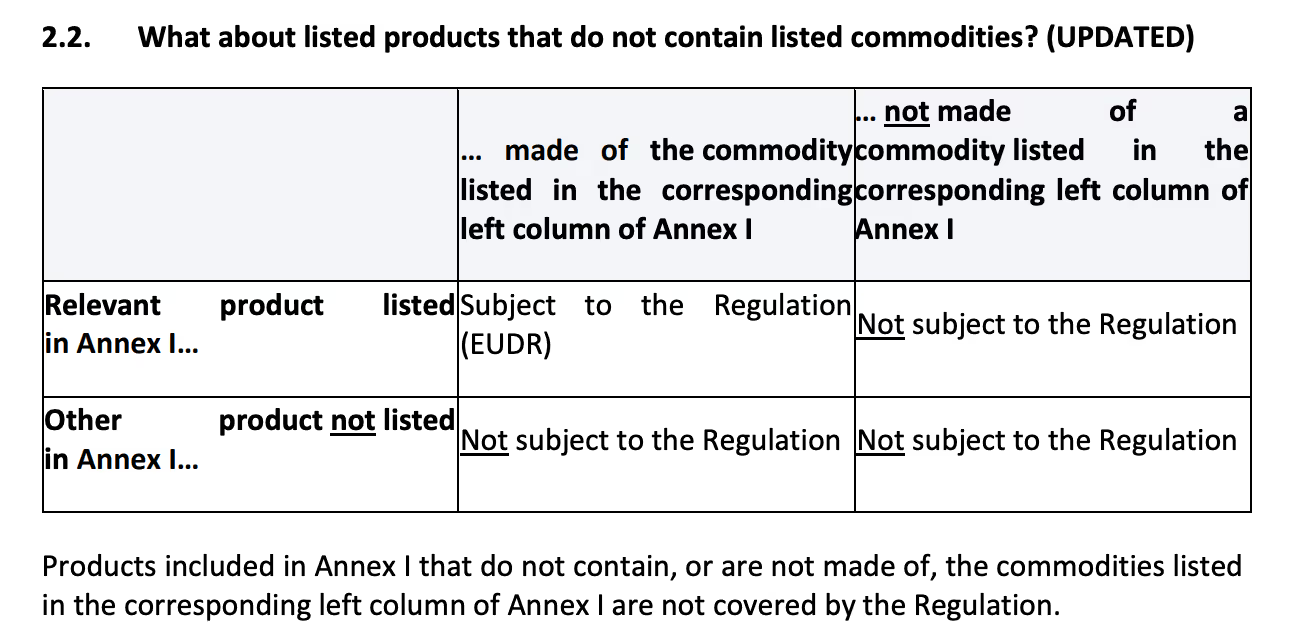As the EU Deforestation Regulation (EUDR) enforcement date draws closer, many organisations across supply chains are grappling with what information needs to be shared - and with whom. To support businesses navigating these requirements, Interu recently hosted a session in our EUDR Lunchtime Webinar Series, led by Andrew Wilsdorf, Head of Customer Success.
The webinar, titled “What to Share with Customers and Suppliers”, focused on helping both upstream and downstream actors understand their data-sharing obligations under the regulation. From clarifying the December 2025 deadline to unpacking due diligence requirements and TRACES functionality, the discussion covered some of the most pressing questions companies are currently asking.
Below, we’ve summarised the key Q&As from the session to help you prepare for compliance and make sense of what’s expected across your supply chain.
EUDR Deadline
- Is the Dec 25 EUDR deadline still current or has it been confirmed as being delayed?
Yes, the 30 December 2025 deadline is still in place. The proposed 12 month delay to the EUDR enforcement was submitted by an individual Member of the European Commission and is not a decision made by the Commission itself.
In terms of what happens next, the Commission will decide whether to discuss the potential delay with the European Parliament and Council, and would need agreement by all 3 parties. Last year this took over 2 months to reach. There is no indication as of the time of writing of when this discussion will take place.
Therefore the most advantageous course of action is to continue preparing for the current deadline.
- As a UK publisher, we are getting push-back from EU customers when we ask about what they need, they say it's been delayed so don't need to do anything yet. This is leaving us to carry on 'in the dark' in terms of customers. What can we do if EU customers aren't addressing it because of the potential delay? I think they are assuming they won't have to do anything as they'll be 'Zero Risk' and no DDS needed, but we will not have the luxury of this.
Our recommendation is that you proactively prepare the necessary documentation and data your customers will need to meet their obligations. Ensuring that you can provide the specific data required secures continued market access to the EU for your products.
This approach will be helpful if there is a delay helping you to navigate stock during the transition period.
Early preparation is viewed as a competitive advantage as you’re demonstrating commitment against greenwashing and deforestation to your customers and suppliers. Having digital systems in place to track and share this information efficiently without manually sharing unstructured documents and data now will reduce the resource requirements for your customers in future, which is key for large buyers.
Due Diligence
- How/When should we conduct the risk assessment?
When should you conduct risk assessment? Before a product can be placed on, or exported from, the EU market, the Operator must be able to prove there is no or only negligible risk of deforestation and degradation (Article 3). Conducting a risk assessment is the middle step of due diligence, the first is collecting the required information (Article 9), and the last is demonstrating risk mitigation. So you must do risk assessment prior to submitting a DDS to TRACES.
How should you conduct risk assessment? Operators must verify and analyse the information collected (Article 9) and carry out a thorough examination and analysis to establish whether there is a risk of non-compliance. The risk assessment must be tailored to the relevant products the operator intends to place on the market and take into account the criteria listed in Article 10(2), which includes:
- Country Risk
- Geolocation Data
- Presence of Forests and People
- Supply Chain Complexity
- Illegality Indications
- Reliability of Information
Interu’s approach is to think about which risks relate to ‘static’ information which does not change regularly (e.g., your products, suppliers, species in your supply chains, countries you source from). And which risks relate to ‘transactional’ information, which can change on a consignment / shipment basis (e.g., manufacturing processes, geolocation information, physical delivery routes). Where possible and responsible, risk assessments can be done every 6 months or annually or static information, and conclusions applied to overall transaction level risks to save you time and re-use due diligence.
- Do we need to assess every supplier in the supply chain right?
If you are the first operator placing the goods on the EU market, then you will be expected to evidence that you have assessed your overall supply chain back to source.
The operator’s obligation to perform due diligence is product-specific, meaning the focus is on tracing the relevant product back to the plot(s) of land on a case-by-case basis. Therefore, unless a simplification applies (see below) operators must carry out a risk assessment (Article 10) for every relevant product supplied. This implies performing due diligence on the end-to-end supply chain originating from that supplier.
This approach has been confirmed as what enforcement authorities will expect to see, most recently by the Dutch NCA (the NWVA), as covered by their excellent report on test EUDR investigations. You can read the report here: https://www.nvwa.nl/onderwerpen/eudr-ontbossingsverordening/nieuws/2025/08/21/nuttige-inzichten-na-proefinspecties-voor-de-ontbossingsverordening-eudr
What simplifications exist which limits the need to assess every supplier in the supply chain?
If you are a downstream non-SME operator or trader, and your products are already covered by upstream DDS (Due Diligence Statements), your obligations are reduced to ascertaining that your suppliers conducted due diligence. This can be achieved by confirming the validity of the suppliers’ DDS reference and verification numbers.
If you are a downstream SME operator or trader, and your products are already covered by upstream DDS, you have no obligations to perform risk assessment back to source. Your obligations are limited to recording and storing information passed to you by your suppliers (and in the case of SME operators, passing information onto your own downstream customers).

- how do you ensure that the human rights part has been properly assessed without going to the actual source?
The EU Deforestation Regulation (EUDR) mandates that human rights due diligence be conducted. This can be achieved by checking that products have been produced by companies who uphold labour rights, international human rights, and the principle of Free, Prior, and Informed Consent (FPIC) for indigenous peoples.
Risk assessments must take into account the presence of indigenous populations in the area of production and the potential for human rights violations. Operators are required to use various forms of documentation, such as public reporting on due diligence efforts and indigenous consultation; results of supplier audits; health and safety reports, etc.
While third-party verification schemes such as FSC and PEFC can offer assistance on this topic, they do not absolve operators of their primary responsibility. If risks are identified, operators must implement mitigation measures, such as independent surveys or audits. Furthermore, authorities have the power to investigate concerns and conduct field audits in third countries.
Interu partners with a number of companies who are experts on this topic - for instance, ingenieursbureau evan buytendijk (IEB), DoubleHelix Tracking Technologies and Preferred by Nature, to support our clients with expert advisory services relating to identifying, assessing, and mitigating the risks of human labour and rights violations, as mandated under EUDR.
Due Diligence Statements & TRACES NT
- How does a downstream operator conduct due diligence by simply passing on DDS RNs/VNs from upstream now it has been made clear upstream suppliers are under no legal obligation to share geolocation downstream?
A key challenge arises from the option to make geolocations confidential within the TRACES system. This makes it difficult for downstream actors to assess crucial information and perform full due diligence.
Working with suppliers, explaining why this information is critical is a good starting point. Some customers mandate sharing geolocations via the DDS in their purchasing contracts. A workaround is to request suppliers to share geolocations directly with you, either via a system like Interu or via another method such as emailing or shared drives.
Depending on your role and position in the supply chain, your obligations to conduct full due diligence may be limited.
- For instance, if you are a downstream SME operator or trader and all products are covered by upstream DDS, you have no obligation to conduct due diligence. See question 4 above.
- If you are a downstream non-SME operator or trader, your obligations can be limited to ascertaining that suppliers have conducted due diligence, by checking the validity of their DDS. However, the downstream non-SME operator or trader still retains liability for non-compliance.
FAQ 3.4 describes what is meant by ascertaining that due diligence has happened.
- “Downstream non-SME operators and non-SME traders ascertain that due diligence was exercised upstream by collecting the reference numbers and verification numbers of DDS submitted upstream and verifying the validity of the reference numbers”. Verification can happen in TRACES directly when submitting your own DDS, and also via a look up in Interu.
- FAQ 3.4 goes further and describes possible additional steps: “non-SME operators and non-SME traders could check the chain of submitted DDS as well as the information provided in previous DDS regarding country of production, quantity and HS codes of declared products and – where available – geolocation and scientific names, in order to verify the completeness and plausibility of the information provided in light of the products they intend to place or make available on the EU market or export. Ascertaining that due diligence was properly carried out does not imply having to systematically check every single due diligence statement submitted by upstream suppliers.
More recent guidance from the August Guidance document: For example, the downstream non-SME operator could verify that upstream operators have an operational and up-to-date due diligence system in place, including adequate and proportionate policies, controls, and procedures to mitigate and manage effectively the risks of non-compliance of relevant products, to ensure that due diligence is properly and regularly exercised.
Information about the point of harvest is really important in order to assess supply chain complexity and the risk of mixing / circumvention back to source. Therefore we recommend that you encourage and motivate your suppliers to share geolocations wherever possible.
- How can we verify the ref number shared by EU suppliers?
When submitting DDS in TRACES and referencing upstream DDS from EU suppliers, TRACES supports EU users by indicating if the reference number does not exist. There is not yet functionality in TRACES to verify DDS without creating your own DDS submission, expect by using an API. And the API can only be used by EU companies at the moment, not non-EU businesses.
Interu allows our users to verify the existence of DDS reference and verification numbers through our direct integration with TRACES.
- When you amend the statement in Traces NT within 72h, does the Reference number stay the same?
Yes, the DDS reference number remains the same once you have submitted the DDS to TRACES. The 72-hour period allows for changes to the DDS’s information, rather than its identification number.
Please be aware that amending (or withdrawing) a DDS within the 72 hour window will not be possible if the DDS reference number has already been used in a customs declaration, referenced in another DDS, if the corresponding product has already been placed or made available on the EU market or exported, or, if the operator or trader was notified about the intention to carry out a check on the DDS, for the period of the check.
Transition Periods
- If paper is produced before Dec 2024, and is now in Asia where it will be used to produce books which will be shipped back to Europe after Jan 1 2026, does EUTR or EUDR apply when importing the book in Europe?
Printed materials, books, newspapers and products of the printing industry are not in scope of EUTR. They are, however, in scope of EUDR.
If the book is made of raw materials sourced and produced entirely out of materials and companies not in the EU, then EUDR will apply fully from 31st December 2025.
If the book is made from pulp from EU sources, or paper produced in the EU, then those raw materials would be considered to have been placed on the EU market during (or before) the transition period. The transition period in this scenario describes the period of time from EUDR being enacted (30th June 2023) to when it will be enforced (31st December 2025) and for books does not relate to EUTR.
In which case, if the books are made of paper (or pulp) which was placed on the market during the transition period, shipped to Asia to be made into books which will be sold in the EU from 31st December 2025, so long as the books are not mixed with any non-EU raw materials, your EU customers importing the book in Europe can use the ‘Universal’ or ‘Conventional’ DDS issued by the EC.
This scenario is covered in our recent webinar on the transition period, get in touch and we will send you the recording and supporting slides.
Composite Products
- If I am an importer of plastic furniture that is not listed in Annex 1, but its legs are made of wood, am I therefore subject to the EUDR?
No. If the product is not listed in Annex I it is not in-scope, even if it is made of products that are in-scope. Please refer to FAQ 2.2 and the table below.

Preparing for EUDR Compliance with Confidence
The path to EUDR compliance may seem complex — especially as details around enforcement, transition periods, and data-sharing obligations continue to evolve. But one message remains clear: preparation is key.
At Interu, we work with companies across the timber, paper, and agricultural sectors (to name a few) to help them collect, verify, and share EUDR-compliant data efficiently through digital tools designed for traceability and transparency.
If you’d like tailored guidance on how to prepare your supply chain or simplify your due diligence workflows, get in touch with our team - we’re here to help you stay compliant, competitive, and confident ahead of the deadline.
***
Disclaimer: We provide a portal for the transfer of data from third party sources to individual users. You are responsible for ensuring that your use of the portal, including the data, is sufficient or appropriate for any particular use or circumstances, including taking independent professional advice as necessary. For the avoidance of doubt, you should always seek independent professional advice to confirm your compliance with applicable law.

.avif)



